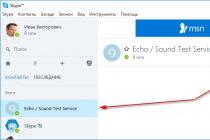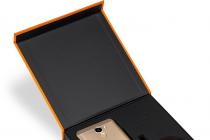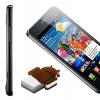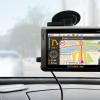The Sony Xperia XZ is a new smartphone from the Japanese company that has taken over the flagship title from the X Performance model. Everyone's beloved letter Z denoting previously top-end devices has surfaced again, but this time as an addition to the new letter “X”, denoting a common line of smartphones. In accordance with the title, the novelty received all the latest developments to date, which the Japanese could only cram into their flagship. At first glance, changes in design are visible, as well as new hardware solutions in the field of photographic capabilities. But whether the innovations will become revolutionary, at least within the model range of the manufacturer, we will find out already in the process of getting closer to Sony Xperia XZ (the Russian-language interpretation of the name brings a touch of mystery, doesn't it 🙂).
DesignXperiaXZ
Sony continue to adhere to its as it turned out to be a strategically correct design concept based on "smoothness and symmetry" and the new Xperia XZ is also made in a similar concept, inheriting the main goal, but already visually perceived in a completely different way! The company's designers named it Loop Surface. The smartphone carries a similar design solution. The lower and upper side frames are absolutely even, while the front part, due to the rounding, smoothly passes into the side surface, which flows similarly to the back cover ... and so on in a circle. In addition, thanks to the metal body, the tactile smartphone feels quite interesting and oddly enough, thanks to the small chamfers, the corners formed in the lower part do not bite into the hand.

The design turned out to be strict and stylish, at the same time rather ambiguous - it evokes emotions in 100% of cases: some have complete admiration, while others, on the contrary; absolutely indifferent to the appearance was not noticed. The screen is covered with 2.5D glass (plus ergonomics and visual perception) and the back cover is made of metal using ALKALEIDO technology - a special material processing that gives depth to color and creates an interesting tactile sensation (this is how the company representative described it).

The dimensions of the case are 146 x 72 x 8.1 (161 grams), which is not far from the usual dimensions of the previous flagships. The color options of the case underline the style of the model: Forest Blue (dark blue), Mineral Black (black) and Platinum (noble platinum). It should be noted that the case is protected from water according to the IP65 / 68 standard. It is a pity that the Xperia engraving was not carried out on the side edge, as was the case with the Z5-series - in our opinion it would have looked very cool.

Technical parameters and capabilitiesSonyXperiaXZ (F8331 / F8332)
Knowing the technical parameters of the new item, I can't help but want to call it Xperia ZX, confusing the letters in the name - after all, this is a real flagship, and we have not been able to completely break the habit of the previous naming of the top line.
The IPS screen with the usual 5.2-inch diagonal with a resolution of 1920 by 1080 pixels with their density of 424 dpi has a high brightness of 600 nits. Not without the use of proprietary technologies such as X-Reality and TRILUMINOS. Despite all the familiarity of the parameters, the screen has become visually better than its predecessors - the depth of the black color has grown significantly, the image is bright and rich, although the colors are somewhat embellished.

Immediately, we note the presence of a waterproof USB Type-C port on the bottom edge of the smartphone. The basis of the hardware part is a Snapdragon 820 chipset with a 4-core 2.2 GHz processor and an Adreno 530 video and 3 GB of RAM. As for the internal storage, there will be 2 options: a version of the Xperia XZ smartphone with 32 GB and one SIM card and a whitened slot for memory cards up to 256 GB, or a version of the Xperia XZ Dual with 64 GB and a hybrid slot, which will allow for choice to use one SIM + microSD memory card or two SIM cards.

The 2900 mAh battery, according to the manufacturer, can easily provide a full working day in a more active mode and up to two days in an average mode of use. The Qnovo Adaptive Charging and Battery Care technologies are used to conserve the battery, while STAMINA and UltraSTAMINA will help save the battery. The fingerprint scanner, which is built into the power button, has not gone anywhere, either. The presence of a special adapter will allow you to use the fast charging function, which cuts its process in half.
Main settings:

Naturally, the smartphone has a whole list of support for modern wireless technologies and other parameters, which does not make sense to describe here, because you can familiarize yourself with them here:
Smartphone cameras - interaction of three sensors
As one of the main players in the market for the production of camera sensors for mobile devices, as well as one of the leading manufacturers of photographic equipment, Sony simply could not but surprise us with some innovation in this area from Sony Xperia XZ. According to the company's representatives, such a set of technical solutions for image processing is used in one smartphone for the first time! Next to the camera's peephole is (perhaps not quite organically in terms of aesthetics) a small panel containing the usual flash and two more new sensors.

The first in this trio is the 23-megapixel camera module itself with a 1 / 2.3 ”Sony IMX300 sensor (Exmor RS sensor), 6 G Lens with f / 2.0 aperture and a BIONZ processor. It also has predictive subject tracking AF and fast focusing.
The next technical innovation was laser autofocus, which allows tracking the distance to the subject and focusing even more efficiently in low light conditions, and even faster focusing in normal mode.
Well, the third technology is the RGBc-infrared sensor, which eliminates the influence of infrared waves, thereby setting the white balance as accurately as possible and making the colors in the photo as realistic as possible. Image stabilization is provided by SteadyShot ™ with Intelligent Active Mode operating in five axes (!) - it works great and has already proven its effectiveness in its predecessors.
Of course, to make it all work as it should, the guys-specialists of the photo division of Sony Alpfa were brought in. But as we know, post-processing software plays an important role in the quality of the final images. Later, we will evaluate the quality of the pictures and the recorded video when we get to know the smartphone.
Well, it was not done without improving the camera application, or rather, its completion and the introduction of new functions. The manual mode became similar to the manual mode - at last, it became possible to adjust not only the white balance, but also the shutter speed (from 1/8 to 1/4000 s), the degree of focus, and exposure. The long-awaited tapu exposure function has also appeared, but without the possibility of additional adjustment.
The front camera also matches the status. A 13-megapixel 1 / 3.06 ”Exmor RS camera with a wide-angle 22 mm lens with an aperture of F2.0 with automatic focusing will allow you to take detailed pictures of yourself in the company of family and friends.
Xperia XZ introduction video
In contact with
Another fundamental (albeit frankly marketing) difference between the Xperia XZ and the Xperia X Performance is the ability to shoot videos in 4K. It is quite good here - the picture is pleasant, the sound is not bad, the settings are sufficient. True, I do not quite understand why it was necessary to do a separate mode for shooting in 4K? Why was it impossible to add the selection of this resolution in the camera settings menu, as is done by other manufacturers?
However, don't think that the Xperia XZ's camera is bad. No, it will still be better than most mid-range smartphones, but there can be no talk of any comparison with flagships. And all these improvements to autofocus, the introduction of stabilization are tantamount to decorating Zaporozhets with garlands in the hope that it will go faster.
Iron and battery
Sony has long and tightly "sits" on Qualcomm hardware, so the Xperia XZ's filling does not present any surprises. Here we have the most sophisticated of the current systems-on-a-chip - Snapdragon 820. The central processor uses 4 cores (2 at 2.15 GHz and 2 at 1.6 GHz), in the role of a graphics accelerator - Adreno 530, and exactly 3 RAM GB. The amount of permanent memory depends on the modification of the smartphone. The model with one SIM card is equipped with 32 GB of internal storage, with two - 64 GB. In the first case, you can install a memory card without problems, and in the second you will have to choose between the second SIM card and the microSD card. Both modifications of the smartphone are "friendly" with cards up to 256 GB. The dual-SIM Xperia XZ has one radio module, so a simultaneous communication session using two SIM-cards is impossible: you cannot call from one SIM card to another, and during a conversation one by one the other is unavailable.
The platform allows you to comfortably play games, watch videos, including 4K clips filmed by the built-in camera. The overall level of performance is exactly the same as that of the Xperia X Performance.
The Sony Xperia XZ phone specifications deserve the highest praise. The manufacturer, when developing a new model range, takes into account the experience of working on smartphones of the Z series, avoiding previous shortcomings and expanding the capabilities of its devices. The Xperia XZ is already the second flagship for 2016, which even surpasses the X Performance in some respects, but at the time of the announcement it costs a hundred dollars more. The smartphone has come to conquer the market with an updated body design, dust and water protection, USB Type-C and hybrid autofocus with record focusing time.
The Sony Xperia XZ smartphone specifications differ depending on the modification, of which there are only two. The model with the digital designation F8331 works with only one SIM card, and the amount of built-in memory is 32 GB. The second modification, the F8332, has a 64 GB drive and support for two SIM cards. Smartphone Sony Xperia XZ price in Russia at the time of writing the review is about 38,000 rubles, and only the 64 GB version is officially available.
Technical specifications Sony Xperia XZ
SoC Qualcomm Snapdragon 820 (MSM8996), 4 Kryo cores @ 1.6 / 2.2 GHz
- GPU Adreno 530 @ 624 MHz
- Operating system Android 6.0.1
- Touch display IPS 5.2 ″, 1920 × 1080, 423 ppi
- Random access memory (RAM) 3 GB, internal memory 32/64 GB
- Support for Nano-SIM (2 pcs.)
- Supports microSD up to 2 TB
- GSM / GPRS / EDGE networks (850/900/1800/1900 MHz)
- WCDMA / HSPA + networks (850/900/1700/1900/2100 MHz)
- LTE Cat.9 Band 1, 2, 3, 4, 5, 7, 8, 12, 13, 17, 19, 20, 26, 28, 29, 32, 38, 39, 40, 41 networks
- Wi-Fi 802.11a / b / g / n / ac (2.4 and 5 GHz)
- bluetooth
- NFC
- GPS, A-GPS, Glonass, BDS
- USB Type-C, USB OTG
- Sony Exmor RS 23MP camera, autofocus, f / 2.0, 4K video
- Front camera Sony Exmor RS 13 MP, f / 2.0, fixed. focus
- Proximity sensor, lighting, magnetic field, fingerprint, accelerometer, gyroscope, barometer, step counter
- Battery 2900 mAh, Quick Charge 3.0
- Dimensions 146 × 72 × 8.1mm
- Weight 161 g
Complete set Sony Xperia XZ
The smartphone comes in a stylish medium-sized box. It is made of thick cardboard. The design of the lower part is complemented by patterns that are installed as standard on the phone's splash screen. Inside is a USB Type-C cable, charger and documentation.
Design
Sony Xperia XZ mobile review begins with a look at its appearance and believe us, we have a lot to tell. The smartphone is very different from the previous flagship released in 2016, which was good for it, especially when you remember how slightly different devices of the Z series were. The case is made of a combination of glass, metal and plastic inserts. Visually, the smartphone is perceived as more rectangular, but in reality its ends are more rounded than in the Xperia X. The bottom and top edges are flat, which allows you to place the phone vertically and not worry that it will fall when the wind blows.
Most of the backdrop is covered with a smooth metal sheet, painted in the general color shade of the case. But for high-quality signal reception from below, it is replaced by a plastic insert. Sony Xperia XZ compact review showed that the manufacturer takes a responsible approach to the assembly of its devices. We did not detect squeaks or inconsistencies between the parts, which allows you to test the waterproofing without the slightest fear.

The manufacturer has placed its logos very elegantly: on the front - Sone, and on the back - Xperia.

The first one is applied in color several shades lighter than the front panel, and on the cover there is a surface engraving. Data regarding certification and IMEI of the device are neatly printed on plastic tape in the SIM tray.

Above the display is an indicator light for missed notifications and two small speaker slots - at the top and bottom for a stereo effect.



Sony Xperia XZ dual f8332 review showed that the bezels surrounding the display were reduced by literally a fraction of a millimeter, but the diagonal was increased from 5 to 5.2 inches. In terms of ergonomics, you can find fault for a long time and there really is something to it. The claims concern the control keys on the right side of the phone.
The power button with a built-in fingerprint scanner is recessed into the body, and the volume rocker is set too low. Looks like the manufacturer is full of desire to repeat the design of digital cameras, where a zoom button is installed near the shutter release. But in a smartphone, such a solution cannot be called ideal, although over time you get used to everything. The same goes for the unusual location of the fingerprint scanner. By the way, it works perfectly, quickly and accurately recognizing the fingerprint.

The bottom keys remain on-screen, the manufacturer is not eager to change its traditions. The review of the Sony Xperia XZ phone goes to its screen, which turned out to be very interesting.
Sony Xperia XZ display
The smartphone has a high-quality IPS-matrix with a diagonal of 5.2 inches and FullHD resolution. The pixel density is very high - 424 ppi. Sony Xperia XZ dual sim review of the display showed that the display is solid in all respects and fully justifies the flagship positioning of the device. The maximum brightness level is almost a record on the mobile market - 629 cd / m2. Sony Xperia XZ f8331 review has shown that it is ideal for our climate, thanks to the comfortable glove mode.

As before, the manufacturer implements its own technologies that improve image characteristics.


The display occupies 70.9% of the front panel area, but there are quite large projections on the top and bottom. There are also those who are dissatisfied with the color rendering, or to be more precise, with the oversaturation of colors. But is this really a problem? You can always go to the settings and specify your settings. In general, the screen is very good and does not require additional settings, but this is a matter of everyone's taste.

Sony Xperia XZ ds 64 gb review showed that the display is at least slightly improved compared to previous models. As we already said, the margin of brightness is large, so that the information is easy to read in all weather conditions, and the increased sensitivity mode is useful in cold weather, when gloves are put on your hands. The colors are rich and the viewing angles are maximized.
Performance Sony Xperia XZ
The Sony Xperia XZ smartphone specifications are what the manufacturer has focused on and has really managed to offer a high-performance, yet long-lasting flagship. Responsible for performance is one of the best chips in 2016 - Snapdragon 820. It has a 64-bit architecture and is built on a 14-nm process technology. Its structure has 2 cores at 1.6 GHz and a similar number at 2.15 GHz.
The Adreno 530 video accelerator provides excellent opportunities for games that are great even on the highest graphics. Sony Xperia XZ specifications will be relevant for at least a few more years, the processor copes with any use case. Its power is especially well revealed in demanding games and when processing video in high quality formats.


The Sony Xperia XZ dual smartphone review showed that the processor heats up noticeably in demanding games and when recording video in 4K, but the heating is not critical, although there is throttling. In other cases, the case remains cold. Sony Xperia XZ features and price are matched perfectly. Of course, you can find a cheaper and more functional phone among the second-tier manufacturers, but among the A-brands it is practically unmatched considering the price.
RAM 3 GB, in this regard, everything has remained unchanged. Many flagships have 4 or even 6 GB of RAM, but here more is not required due to good system optimization. Performance is maintained even when working with several applications, and they are not unloaded from memory. A review of the Sony Xperia XZ showed the return of moisture protection, which is certainly encouraging. The built-in memory can be 32 or 64 GB.

In the two-SIM version, support for a memory card with a capacity of up to 256 GB is declared, which is installed instead of the second SIM. In a monosymbol device, everything is more thoughtful - you can place a memory card in a separate tray.
Subscribe to ourThe life cycle of a modern smartphone on the assembly line is already short-lived, and Sony decided to shorten it even further. Now the company fires new flagships every six months, and it cannot be said that they are very significantly different from their predecessors.
Xperia XZ got to testing already on the eve of the release of the new flagship. the site has just started its work, so it was simply not possible to conduct testing before, but you cannot miss such an interesting gadget. So, the smartphone received a 5.2-inch FullHD-display, 3 GB of RAM and 64 GB of ROM, a high-performance SoC Qualcomm Snapdragon 820, 23 and 13 MP cameras, as well as an IP65 / 68-protected case. What else? Read on.
Specifications
| Display size and type | 5.2 inches, 1920 x 1080 pixels, IPS, capacitive multitouch |
| CPU | Qualcomm Snapdragon 820, 4 cores (2 × 2.15 GHz + 2 × 1.6 GHz) |
| Graphics accelerator | Adreno 530 |
| Built-in memory, GB | 64 |
| RAM, GB | 3 |
| Memory expansion | microSD (up to 256 GB) |
| Number of SIM-cards | 2 |
| Communication standards 2G | 850, 900, 1800, 1900 MHz |
| 3G communication standards | 800, 850, 900, 1700, 1900, 2100 MHz |
| 4G communication standards | 700, 800, 850, 900, 1700, 1800, 1900, 2100, 2300, 2500, 2600 MHz |
| Wi-Fi | Wi-Fi 802.11b / g / n / ac, 2.4 / 5 GHz |
| Bluetooth | 4.2 BLE |
| NFC | There is |
| IrDA | Not |
| USB port | USB Type-C |
| 3.5mm jack | There is |
| FM radio | Not |
| The fingerprint scanner | There is |
| Navigation | GPS / A-GPS, GLONASS, BeiDou |
| Built-in sensors | Accelerometer, Proximity Sensor, Hall Sensor, Magnetometer, Light Sensor, Fingerprint Scanner |
| Main camera | 23 MP, Exmor RS 1 / 2.3 "sensor, f / 2.0 |
| Front-camera | 13 MP, Exmor RS 1 / 3.06 ", f / 2.0 |
| Operating system | AndroidTM 6.0 (upgrade to Android 7.0) |
| Protection class | IP65 / IP68 |
| Battery | 2900 mAh |
| Dimensions, mm | 146 x 72 x 8.1 |
| Weight, g | 161 |
Appearance and usability
The design of Sony smartphones has always been recognizable and stood out against the background of hundreds of monotonous devices that can only be identified without a logo by looking closely. At the same time, the design of Xperia smartphones is constantly progressing. The current one is called Loop Surface, which literally can be translated as "looped surface". Sounds pretty funny, especially considering the sharp angles when viewed from above. But the left and right side surfaces are rounded, and symmetrically. The upper and lower edges are also absolutely identical in shape and differ only in the functional elements installed on them. The smartphone is protected according to the IP65 / 68 standard, so it is not only not afraid of dust and splashes, but it can also dive to a depth of one and a half meters without consequences.
The front side is completely covered with Gorilla glass (the generation is not specified, but most likely it is Gorilla Glass 4) with the 2.5D effect, thanks to which the display seems to flow into the rounded sides. The back panel is made of ALKALEIDO aluminum alloy. The name ALKALEIDO itself consists of the words aluminum and kaleidoscope. This alloy was developed by Sony in conjunction with the 100-year-old company Kobe Steel, which specializes in ferrous metallurgy, as well as copper and aluminum products. The main challenge for the alloy developers was to create a surface that would look good when viewed from any angle. The surface of the lid really looks great, and the coating is not afraid of scratches, but there is no "wow" effect. Prints on dark color options are too noticeable, so you have to wipe the back panel quite often, but the display, thanks to the oleophobic coating, on the contrary, is rare.
On the front, at the top and bottom of the display, there are a pair of speakers. At the top, there are also proximity / light sensors, a front camera and an LED indicator. There is also an NFC area.
From the back side you can see the flash, the auxiliary camera sensor unit, as well as the rear camera itself.
On the left side surface there is only a tray for installing SIM cards, one of which can be replaced with a microSD memory card. Removing the tray overloads the smartphone. Apparently, this is such a protection algorithm.
All physical keys are installed on the right side surface. Namely - the volume control swing key, the physical photography key, which is so often lacking in most modern smartphones, as well as the power key combined with a fingerprint scanner. The scanner has no additional functions.
After using the smartphone for a week, the impression was that the manufacturer wanted to please both right-handers and left-handers. And in part he did it. When operating the phone with the left hand, the power key fits neatly under the index finger, the volume keys under the middle and ring finger, and the photo button in portrait mode is well placed under the little finger. At the same time, accidental clicks are practically excluded. After the personal Xiaomi Mi5, the tested smartphone was a godsend in terms of convenience for the left-hander. But right-handers have to press on all keys with their thumb. And if the power key is extremely convenient, then with the volume keys it is already more difficult, and the shutter button in portrait mode is completely inaccessible for a right-handed person. But on the other hand, in landscape mode, the location of the shooting key is the same as in most compact cameras, which is convenient and familiar.
On the upper side surface there is a mini-jack 3.5 audio jack and a microphone. A second microphone and a USB Type-C connector are installed on the bottom edge.
Display
The smartphone uses a 5.2-inch IPS-matrix with FullHD resolution. The matrix with 4K resolution was not used, apparently, in order to save money, but not budget, but battery power, because displays with high resolution are quite gluttonous. At the same time, there is no special need for such a high resolution with a 5-5.5-inch screen diagonal. Of course, the display has a polarizing filter, an oleophobic coating, a touch layer with support for up to 10 simultaneous touches, and the display itself is made using OGS technology, that is, without an air gap.
The display settings provide three modes of operation - standard, X-Reality for mobile and the maximum brightness mode, but these modes work only in the pre-installed applications for viewing photos and videos. With the maximum brightness of the backlight, the luminosity of the white field was 551.47 cd / m2, and the luminance of the black field was 0.45 cd / m2, which gives the final static contrast ratio of 1225: 1.
Automatic backlight brightness control works correctly and, from a subjective point of view, the algorithm is extremely successful. With a sharp change in the illumination level from 400 to 1 lux (for example, when the light is turned off in a dark room), the backlight brightness drops to a minimum, not abruptly, but smoothly, or rather very smoothly - about 80 seconds. During this time, the eyes have time to get used to the darkness, as a result of which the image with low backlight brightness does not appear dim. When you turn on a powerful light source, the brightness level of the backlight increases to the maximum in just a couple of moments. To save battery power, you can activate activity detection, which automatically turns off the screen when the user is not using the smartphone. Also of the features worth noting is the control mode with gloves.
The colors on the display are not very accurate, and the color temperature is too high, but there is the possibility of adjustment with three sliders (RGB). The color gamut is huge and close to AdobeRGB. Below are the measurement results in default display mode.
Sound
The earpiece speaker, in addition to the main function, also plays the role of the second system speaker, which allows you to reproduce stereo sound. The speakers sound good. The sound is clear, detailed with a tangible high frequency range and noticeable bass. But the volume is not enough. For example, the personal Xiaomi Mi5 is much louder, even if it sounds like it was covered with an iron bowl. When connecting headphones or a headset, it is possible to activate the modes of automatic sound optimization, noise reduction (when using headphones with this function), in addition, it is possible to control the microphone sensitivity. There is also a dynamic normalizer, the ClearAudio + function and DSEE HX, which, according to the manufacturer, restores the high frequencies when listening to compressed formats (only works with wired headphones). The list of special effects includes 5-band equalizer with ClearBass function (hello from Walkman), various surround modes and realistic surround sound reproduction function.
Despite this abundance of various sound enhancement functions, the Sony Xperia XZ under test does not have a separate audiophile DAC and amplifier. Although from the creators of the Walkman, which once served as a household name for any pocket player, this is expected in a flagship smartphone. However, the sound reproduction is excellent by smartphone standards. When testing the audio output quality in the Right Mark Audio Analizer 6 package using an external sound card E-MU 0204 USB, the final score was "excellent". Smooth frequency response and high signal-to-noise ratio.
Overall results
Frequency response
| Left | Right | |
| 20 Hz to 20 kHz, dB | -0.20, +0.01 | -0.30, -0.19 |
| 40 Hz to 15 kHz, dB | -0.08, +0.01 | -0.25, -0.19 |

Will it swing or not? An eternal question for fans of mobile music and headphones with higher impedance. The norm for smartphones can be considered 150-250 mV. Voltage measurements when applying a sinusoidal signal with a frequency of 1 kHz and operating into a 32 Ohm load showed a result of 275 mV. For comparison, the personal Xiaomi Mi5 produced 197.1 mV under the same conditions, and the recently described one (aka Huawei Mate 9 Lite and Honor 6x) - 175.7 mV.
Performance
The Sony Xperia XZ smartphone, like most flagships in 2016 and early 2017, is equipped with a Qualcomm Snapdragon 820 (MSM8996) SoC. This is a 4-core solution made on a 14 nm process technology based on the Kryo architecture. A couple of cores operate at 2.15 GHz, and two more at 1.7 GHz. Responsible for the graphics part is the Adreno 530 operating at 624 MHz. LPDDR4 memory operates at 1866 MHz. The 3GB RAM is not impressive, but sufficient for any task. The ROM volume of the tested smartphone is 64 GB. A modification with 32 GB of on-board memory is also available.
This slideshow requires JavaScript.
System performance was measured in synthetics PCMark, 3DMark, Geekbanch 4 and AnTuTu v6.2.7. Memory speed was evaluated using the AndroBench app



Testing was also carried out in cross-platform javascript tests (Mozilla Kraken JavaScript and SunSpider). The results of these tests significantly depend on the browser used, therefore, to minimize the impact, all reviews will use Google Chrome as the most common one.

Even the most demanding smartphone games of 2016 are not a problem. We set the maximum quality settings, and go ahead for the orders. At the same time, even after an hour of playing, there were no problems with significant overheating and throttling.
Camera
Sony is quite successfully promoting its mirrorless cameras, and in general, the manufacturer has plenty of experience in the field of photo and video equipment. Moreover, Sony is the main supplier of camera sensors for most smartphones. Of course, Sony's matrices are installed in the main competitors. But if competitors, realizing the absurdity of the war of resolutions, order 12-16 MP matrices from Sony, Sony for its flagship uses an exclusive IMX300 Exmor RS sensor with a resolution of 23 MP and a physical size of 1 / 2.3 ”. At the same time, instead of optical stabilization, only 5-axis electronic, and f / 2.0 aperture. In comparison, the Samsung GALAXY S7 is equipped with a 12MP Sony IMX260 Exmor RS sensor and an f / 1.7 aperture for better low-light performance. In general, the manufacturer has clearly got excited here, because it is much more difficult to process an image with a 23 PM resolution than 12 MP, and processing flaws are much more noticeable.
As for the autofocus operation, the camera has many trump cards. Predictive autofocus, phase sensors built into the matrix, as well as a laser rangefinder. Focusing is incredibly fast and often very accurate. And if, when shooting distant objects, this is not surprising, because a small sensor has a large depth of field, then a laser rangefinder helps out great at short distances. In addition, there is a built-in infrared sensor to help you more accurately identify colors. In general, the range of various additional camera modules is impressive.
The front camera also has a relatively high resolution - 13 MP, but only with the usual contrast autofocus without any additional functions.
This slideshow requires JavaScript.
The standard photo shooting control program provides for the so-called "super automatic", as well as manual mode. To change the settings yourself, the following parameters are available: autofocus operating mode, white balance, exposure compensation, shutter speed, sensitivity (ISO 50-3200) and resolution. It also provides activation of the HDR modes, self-timer for detection of a smile and tracking the subject of shooting. The latter works almost flawlessly. Even in advanced DSLRs and mirrorless cameras, this kind of AF tracking accuracy is rare. However, here again the large depth of field affects, which greatly facilitates the work of the focusing unit. But still, among the competitors, the Sony Xperia XZ has unambiguously the best tracking autofocus. The smartphone is capable of transferring full control to a third-party program. But, unfortunately, even in third-party programs it is impossible to shoot in RAW format. To assess the image quality, the test pattern was captured with all available sensitivity values. Below are the crop fragments.
Sample pictures
Filming
In the video mode, FullHD-clips can be recorded in 30p and 60p modes, which is pleasantly pleasing. However, scene selection is not possible in 1080 / 60p mode. The 4K video recording mode is tucked away in the list of advanced features, which is a little awkward. In the settings, you can select the white balance setting and the introduction of exposure compensation. In addition, when recording 4K videos, a choice of codec is provided - H.264 or H.265. The data stream when recording 4K video and using the H.265 codec is 35 Mbit / s, but the use of the H.264 codec leads to an almost twofold increase in the bit rate (up to 56.1 Mbit / s) with comparable picture quality. The bitrate of a FullHD movie in 60p format is 30 Mbps, and at 30 frames per second - 19.4 Mbps.
Battery and autonomous work
The smartphone uses a 2900 mAh battery. Not too many. Sure, the Xperia XZ has Stamina and Ultra Stamina modes, which partially disable the smartphone's functions, but that doesn't make it much easier. In reading mode, the device lasted only 12 hours and 20 minutes. In game mode - 4 hours 20 minutes. When playing a FullHD video in MX Player with a backlight brightness of 200 cd / m2, the smartphone lasted 11 hours and 18 minutes, which is already quite good. In addition to various modes of saving battery power, the smartphone software also worries about the safety of the energy source. The battery saver function detects when the phone is normally disconnected from the charger and calculates the charging pattern for that time. Thus, up to 90% of the capacity of the battery replenishes forces in normal mode, and the charging of the last 10% is completed by a certain time of the usual termination of charging. In theory, this feature can double the battery life. In general, it is convenient, but I would like to be able to manually indicate the end time of charging.

Conclusion
Sony has made a great smartphone. A beautiful and recognizable design may be controversial, but it has a fan base. In addition, the Xperia XZ is equipped with a pair of high-quality stereo speakers, it has excellent sound from the analog audio output, and the output level is sufficient to drive the headphones with medium impedance. The tested smartphone has a bright and high-contrast display, besides, the color gamut is close to AdobeRGB. Of course, the color temperature is traditionally overstated for Sony, but thanks to the ability to adjust the color by RGB channels, the color rendition can be adjusted manually. There is enough performance in any situation and for any application. And all this stuff is placed in a case protected by class IP65 / 68. Of the shortcomings, it is worth noting that the short battery life in reading mode, and also, with a stretch, the disadvantages include a hybrid tray if 64 GB of internal memory is not enough for you.
But competitors have all this, and something is even better. Driving out on protection from dust and moisture will not work, because this is no longer an exclusive feature of Sony. And there is still work to be done with the built-in camera. In general, we will wait for new Sony products at MWC 2017 and compare them with the current flagship. Sony is obliged to at least surprise, otherwise it will be difficult to overcome the milestone of 1% of global smartphone sales. In addition, 2017 is a milestone year for Sony's mobile division, and if the division does not start to make a profit, then the fate of the Sony VAIO division awaits it.
UPD: February 28, 2017 in Barcelona onMWC 2017 presented two heiresses at onceXZ - slightly updatedXZs andXZPremium with screen 4KHDR and processorSnapdragon 835.XZ Premium was officially recognized as the best smartphone by MWC 2017, pushing out other high-profile novelties in the face of LG G6 and Huawei P10

More recently, cameras in Sony phones were so highly rated that devices from Samsung and Apple were left to swallow dust. However, in recent years, the role of camera phones has been more often tried on. But this year Sony decided to tell the market that there is still gunpowder in the flasks. The manufacturer did not chase trends, installing a dual camera, preferring one, but the most top-end sensor. The back is adorned with a 19-megapixel Motion Eye camera (IMX400) with an f / 2.0 aperture. And this is a truly innovative system. Why?
Sony used a special memory that took place between the sensor and the control circuits. It serves as a kind of buffer where frames are temporarily stored without waiting for writing to the main memory. As a result, this has a positive effect on the sensor reading speed. In addition, it is the built-in memory that allows you to record slow-mo video at 960 fps, while most smartphones can record at 240 fps at best. Without even going deep into the characteristics of the camera Sony Xperia XZ1, it can be confidently called one of the best on the market. Sony did not take the quantity, presenting one, but high-quality module.
As for the photo quality itself, the Xperia XZ1 is comparable to another smartphone from the company - XZ Premium. It also uses a Motion Eye sensor. In the afternoon, the photos are just great. Lots of detail, minimal noise, wide gamut and accurate colors. In low light, the quality of photos, of course, drops, but still remains at a fairly acceptable level.





Video on the Sony Xperia XZ1 can be recorded at a maximum 4K resolution. You can record 1080p videos at 30 or 60 fps. In 720p, you can record video at up to 960 fps. The videos on the Sony Xperia XZ1 are very, very decent.
Front camera of 13 megapixels with f / 2.0 aperture. A solid sensor that supports FullHD video recording. The pictures are detailed and clear. There are additional modes. In general, the camera's capabilities are more than enough to create good selfies.
3D modeling
Perhaps the most entertaining feature of the Sony Xperia XZ1. A proprietary development of a Japanese company that allows you to create 3D models of various objects using a camera. The technology looks really interesting and promising. The principle of the function is well laid out in this video:
With scanned models, you can do a bunch of different actions, from processing them directly on your smartphone to printing them on a 3D printer. What's more interesting, the system is self-learning. The manufacturer promises that with each subsequent scan we will receive more and more high-quality models. I am glad that Sony is not lagging behind other companies, developing technologies for augmented and virtual reality.
Autonomy
Let's not beat around the bush - the 2700 mAh battery for the Sony Xperia XZ1's specifications seems very, very small. However, the smartphone continues to pleasantly surprise us. It is not clear what affected the autonomy (more efficient chipset process technology or software optimization), but the Xperia XZ1 shows autonomy results that are superior to smartphones with 3000+ mAh batteries. Probably, the limitation of background processes is really affected, which is one of the main features of the updated OS.
Naturally, you should not expect that the smartphone will be in active mode for a record amount of time. With active use, whatever one may say, the Sony Xperia XZ1 will have to be charged in the evening. In video playback mode, the smartphone shows an amazing 11 and a half hours of battery life, in web surfing mode - 2 hours less.
The smartphone supports modern fast charging technology - QuickCharge 3.0. The battery can be filled up to 60% in just 30 minutes.
Sony Xperia XZ1: where to buy, price, analogs
In Russia, the Sony Xperia XZ1 starts at a price of 49,990 rubles. The date of the start of sales of the smartphone is scheduled for October 11. Between September 27 and October 3, the company will be accepting pre-orders. Pre-order customers will receive branded noise canceling headphones as a gift. Elsewhere, the Sony Xperia XZ1 can be purchased for around $ 775.
What can be considered analogs of Sony Xperia XZ1? Yes, in principle, any of the latest flagships of 2017.
- Samsung Galaxy S8. An excellent smartphone that has been on sale for almost six months. Powerful hardware, first-class cameras, 18: 9 display.
- ... A novelty by another Korean company, presented at IFA 2017. In Russia, it should start in October. Offers top-end "stuffing", flagship cameras and a large display with thin bezels.
- ... Smartphone in a more classic design. Great screen, great cameras and top-end hardware.
Conclusion and review Sony Xperia XZ1
Despite its wide bezels, lack of a dual camera and classic design, the Sony Xperia XZ1 makes a good impression. The smartphone looks stylish, it has advanced hardware, a top-end sensor for the main camera, it runs the latest version of Android, it has excellent stereo sound and a bunch of less noticeable innovations. Why isn't it a flagship ?! It's hard to find fault with the Sony Xperia XZ1. Some roughness of the firmware and software from the manufacturer will be "finished" in subsequent updates, which in turn will affect the performance. True connoisseurs of Sony smartphone design will also appreciate the Xperia XZ1, and non-connoisseurs are unlikely to consider the device. Even the battery, despite expectations, did not disappoint.
The Sony Xperia XZ1 is a good smartphone, but not for everyone. At a price of almost 50,000 rubles, it has a lot of alternatives that have a better chance of success due to various trend features - a dual camera, a frameless screen. Is the Sony Xperia XZ1 worth the money? Rather yes than no. Show me a flagship smartphone from an AAA brand that would have been much cheaper at launch.














